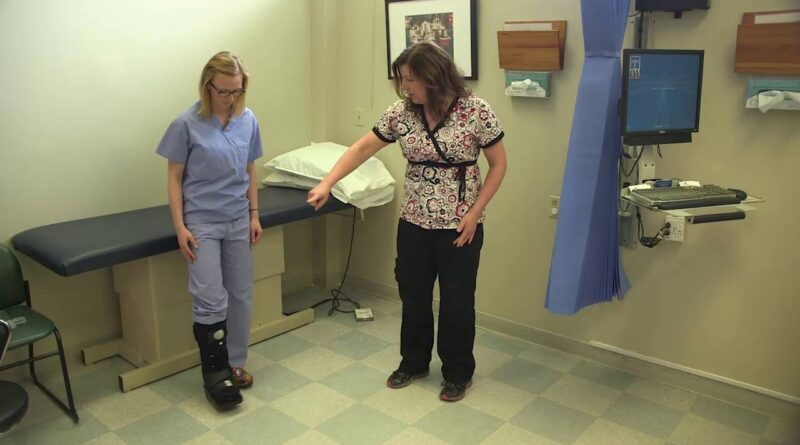Do you need crutches with a CAM boot?
After surgery, your foot is protected with a walking boot to prevent further injury to the foot and help your injuries recover more quickly and painlessly. These orthopedic shoe aid in reducing recovery time and hastening your return to independent walking.
So, if you have a walking boot, do you need crutches? No, using crutches is not necessary when wearing a walking boot. Having said that, there may be instances in which your doctor advises you to use mobility assistance while using a walking boot. Crutches, wheelchairs, walkers, and even canes are examples of these.
Describe walking boots:
A walking boot, also known as a CAM boot, is a boot that sits below the knee and is categorized as an orthopedic device to help stabilize the foot or ankle in the event of a sprain, fracture, ligament rupture, surgery, or tendon tear.
These boots are worn so that the person wearing them can heal more quickly and pleasantly. Most CAM boots include two to five movable straps that extend up your leg from the ankle to your calf.
For more information:
https://lumbuy.com/best-cam-boot-for-ankle-injuries/
Steps for Putting On Walking Boots:
Following the steps below will make it simple to put on walking boots. If you can, wear a sock on the foot that will be wearing the boot; it might feel more comfortable.
- Place your heel completely on the back of the walking boot when sitting.
- Next, start at your foot and wrap the linear around each one, working your way up.
- After that, affix the front piece to the liner.
- Next, secure the straps by working your way up the boot, beginning at the bottom with your toes.
- Straps being tightened. The boot should fit snugly but not so tightly that it becomes unconvertible.
- If your boot has an air chamber, now is the moment to fill it. To find out how much air you should be utilizing, speak to your physician or physical therapist.
- See how it feels when you stand up. Start out walking slowly.
- Make sure to deflate the air chamber before removing the boot.
When Do You Use Walking Boots?
When a doctor determines that a walking boot is required to aid in the healing process and improve comfort, walking boots are worn when an injury occurs from the toes to the ankle. They’re also employed following surgery. For instance, a walking boot could be advised following bunion surgery to aid in the recovery process. People who fracture their feet are frequently placed in a boot to recuperate.
How to Properly Walk in a Walking Boot Without a Crutch:
You can put weight on the hurt foot by using the walking boot as intended. It may feel strange or awkward at first to wear a walking boot, but with a little practice, you will soon be able to walk.
First of all, be aware that the boot will, for the most part, be a little higher than your average pair of sneakers or walking shoes. We advise you to wear something comparable on the opposite foot to compensate for the height disparity. When you initially begin, you could feel unsteady, and a cane or walker might be required for stability.
If you can, practice at home or even with a therapist. You’ll soon get used to your boot and walk without any problems.
Crutches and Boots for Walking:
Another common walking device that is useful when one foot, knee, or leg needs to be removed from it due to an injury is a pair of crutches. Even though crutches are normally used alone, walking boots can be worn when necessary. Crutches can assist you to remove the weight from an injury so that it can heal more quickly, even if it is a serious sprain.
You should use crutches and a walking boot if your doctor advises you to. Depending on the type of crutch used, it may help relieve some or all of the weight from the damaged leg and walking boot. Crutches are only meant to be used as a temporary walking aid.
Utilize a walker:
With a walking boot, using a walker can be an option. A walker can provide significantly superior support while wearing a walking boot, especially for the elderly. Walkers, which have a lightweight frame and a height of around three feet, are a fairly common form of mobility aid.
Because of its design, a walker merely provides you with support on all sides. To maneuver the walker, you can either take it up or move ahead while putting it down to regain balance and weight for the next step.
employ a cane:
When using a walking boot, another alternative that can assist with walking is a can. One of the smallest mobility aids you can employ to assist with movement is a cane. A cane may be light, but it can also be incredibly sturdy and offer fantastic support. Do not mix a cane with a walking stick; they are two distinct objects.
Conclusions About Using Crutches With A Walking Boot:
Even though using a cane, crutches, or even a walker with a walking boot is uncommon, there are situations when a doctor will advise you to do so. Another mobility gadget may be just what you need to keep moving while using a CAM boot if you require more assistance while walking with a boot. Read more on wpc2027.




